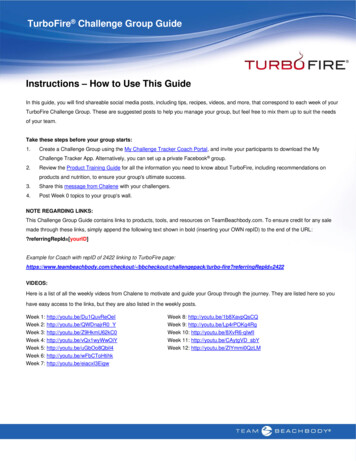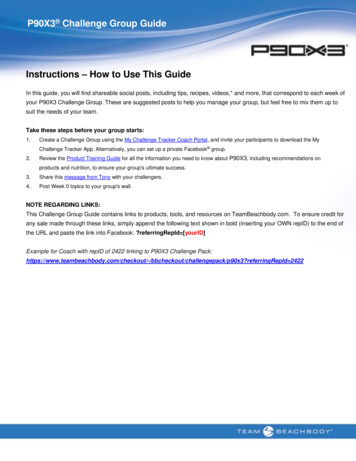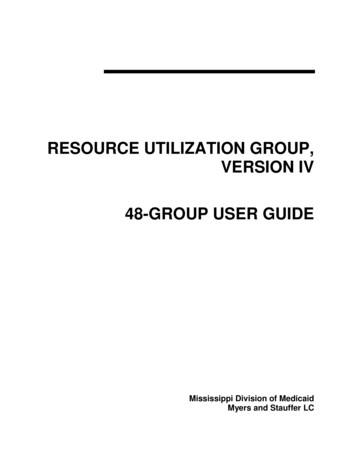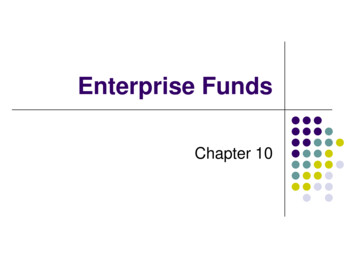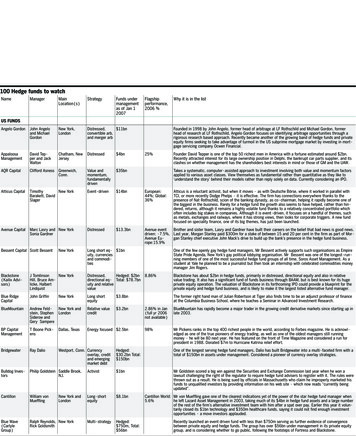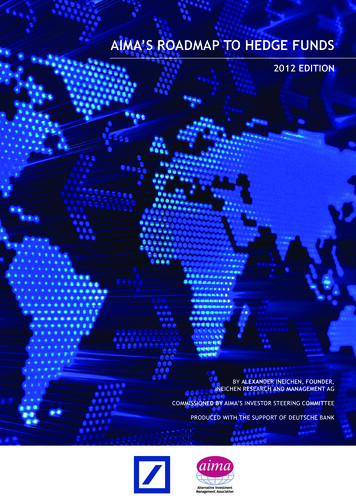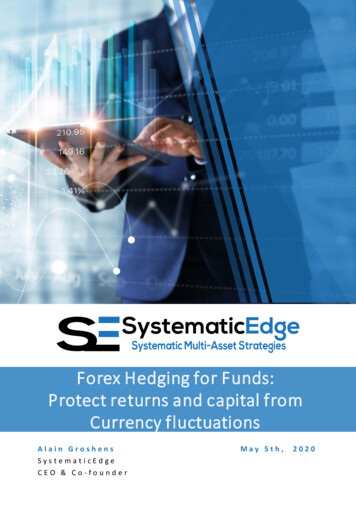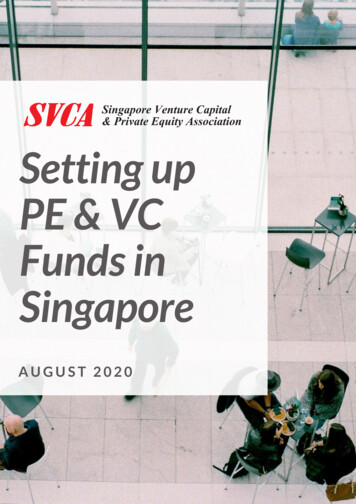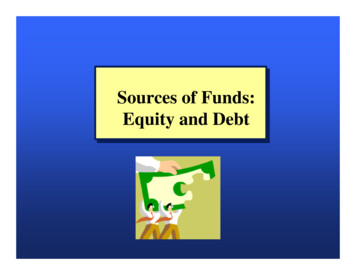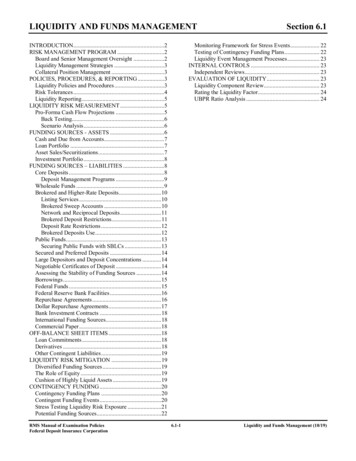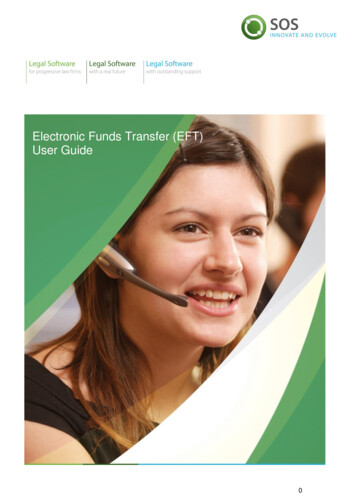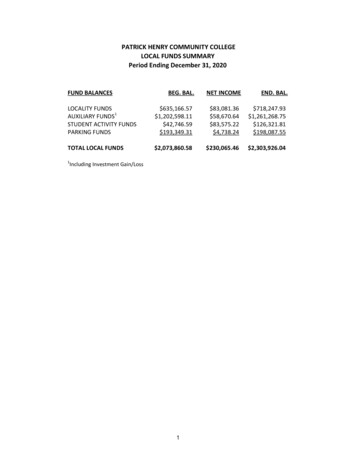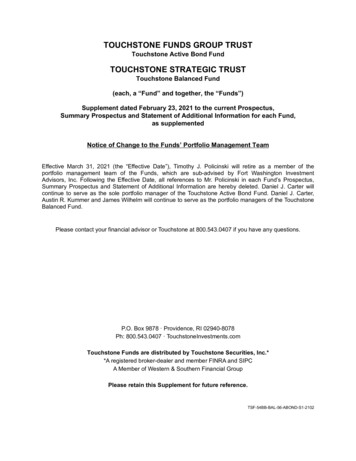
Transcription
TOUCHSTONE FUNDS GROUP TRUSTTouchstone Active Bond FundTOUCHSTONE STRATEGIC TRUSTTouchstone Balanced Fund(each, a “Fund” and together, the “Funds”)Supplement dated February 23, 2021 to the current Prospectus,Summary Prospectus and Statement of Additional Information for each Fund,as supplementedNotice of Change to the Funds’ Portfolio Management TeamEffective March 31, 2021 (the “Effective Date”), Timothy J. Policinski will retire as a member of theportfolio management team of the Funds, which are sub-advised by Fort Washington InvestmentAdvisors, Inc. Following the Effective Date, all references to Mr. Policinski in each Fund’s Prospectus,Summary Prospectus and Statement of Additional Information are hereby deleted. Daniel J. Carter willcontinue to serve as the sole portfolio manager of the Touchstone Active Bond Fund. Daniel J. Carter,Austin R. Kummer and James Wilhelm will continue to serve as the portfolio managers of the TouchstoneBalanced Fund.Please contact your financial advisor or Touchstone at 800.543.0407 if you have any questions.P.O. Box 9878 · Providence, RI 02940-8078Ph: 800.543.0407 · TouchstoneInvestments.comTouchstone Funds are distributed by Touchstone Securities, Inc.**A registered broker-dealer and member FINRA and SIPCA Member of Western & Southern Financial GroupPlease retain this Supplement for future reference.TSF-54BB-BAL-56-ABOND-S1-2102
January 30, 2021ProspectusTouchstone Funds Group TrustTouchstone Active Bond FundTouchstone Anti-Benchmark International Core Equity FundTouchstone Credit Opportunities Fund(formerly, Touchstone CreditOpportunities II Fund)Touchstone High Yield FundTouchstone Impact Bond FundTouchstone International ESG Equity FundTouchstone Mid Cap FundTouchstone Mid Cap Value FundTouchstone Sands Capital SelectGrowth FundTouchstone Small Cap FundTouchstone Small Cap Value FundTouchstone Ultra Short Duration FixedIncome FundClass SClass s YClass ZInstitutionalClassClass ATMCTXClass R6TSNRXThe Securities and Exchange Commission has not approved or disapproved these securities or determined if this prospectus isaccurate or complete. Any representation to the contrary is a criminal offense.You may elect to receive all future annual and semi-annual shareholder reports in paper, free of charge. If you already elected toreceive shareholder reports electronically, you will not be affected by this change and you need not take any action. To elect toreceive paper copies of shareholder reports through the mail or otherwise change your delivery method, contact your financialintermediary or, if you hold your shares directly through Touchstone Funds, visit TouchstoneInvestments.com/Resources/Edelivery or call Touchstone Funds toll-free at 1.800.543.0407. Your election to receive shareholder reports in paper will applyto all Touchstone Funds that you hold through your financial intermediary or directly with Touchstone.
Table of ContentsPageTOUCHSTONE ACTIVE BOND FUND SUMMARYTOUCHSTONE ANTI-BENCHMARK INTERNATIONAL CORE EQUITY FUND SUMMARYTOUCHSTONE CREDIT OPPORTUNITIES FUND SUMMARYTOUCHSTONE HIGH YIELD FUND SUMMARYTOUCHSTONE IMPACT BOND FUND SUMMARYTOUCHSTONE INTERNATIONAL ESG EQUITY FUND SUMMARYTOUCHSTONE MID CAP FUND SUMMARYTOUCHSTONE MID CAP VALUE FUND SUMMARYTOUCHSTONE SANDS CAPITAL SELECT GROWTH FUND SUMMARYTOUCHSTONE SMALL CAP FUND SUMMARYTOUCHSTONE SMALL CAP VALUE FUND SUMMARYTOUCHSTONE ULTRA SHORT DURATION FIXED INCOME FUND SUMMARYPRINCIPAL INVESTMENT STRATEGIES AND RISKSTHE FUNDS’ MANAGEMENTCHOOSING A CLASS OF SHARESDISTRIBUTION AND SHAREHOLDER SERVICING ARRANGEMENTSINVESTING WITH TOUCHSTONEDISTRIBUTIONS AND TAXESFINANCIAL HIGHLIGHTSAPPENDIX A — INTERMEDIARY-SPECIFIC SALES CHARGE WAIVERS AND 6
TOUCHSTONE ACTIVE BOND FUND SUMMARYThe Fund’s Investment GoalThe Touchstone Active Bond Fund (the “Fund”) seeks to provide as high a level of current income as is consistent with thepreservation of capital. Capital appreciation is a secondary goal.The Fund’s Fees and ExpensesThis table describes the fees and expenses that you may pay if you buy and hold shares of the Fund. You may qualify for salescharge discounts for Class A shares of Touchstone equity funds and Touchstone fixed income funds if you and your familyinvest, or agree to invest in the future, at least 25,000 or 50,000, respectively, in Touchstone funds. More information aboutthese and other discounts is available from your financial professional, in the section titled “Choosing a Class of Shares” in theFund’s prospectus and Statement of Additional Information ("SAI") on page 93 and 101, respectively, and in Appendix A–Intermediary-Specific Sales Charge Waivers and Discounts to the Fund's prospectus. If you purchase Class Y shares through abroker acting solely as an agent on behalf of its customers, that broker may charge you a commission. Such commissions, ifany, are not charged by the Fund and are not reflected in the fee table or expense example below.Class AShareholder Fees (fees paid directly from your investment)Maximum Sales Charge (Load) Imposed on Purchases (as apercentage of offering price)Maximum Deferred Sales Charge (Load) (as a percentage oforiginal purchase price or the amount redeemed, whichever is less)Wire Redemption Fee*Annual Fund Operating Expenses (expenses that you pay eachyear as a percentage of the value of your investment)Management FeesDistribution and/or Shareholder Service (12b-1) FeesOther ExpensesAcquired Fund Fees and Expenses (AFFE)Total Annual Fund Operating Expenses (1)Fee Waiver and/or Expense Reimbursement (2)Total Annual Fund Operating Expenses After Fee Waiver and/orExpense Reimbursement(1) (2)Class CClass YInstitutionalClass3.25 %NoneNoneNoneNoneUp to 151.00 %Up to 15NoneUp to 15NoneUp to 28%%%%%%0.39 %None0.34 %0.01 %0.74 %-0.08 %0.39 %None0.24 %0.01 %0.64 %-0.06 %1.66 %0.66 %0.58 %%%%%%%0.91 %*The wire redemption fee is capped at 15. In addition, the wire redemption fee may not exceed two percent (2%) of the amount beingredeemed.(1)Total Annual Fund Operating Expenses include Acquired Fund Fees and Expenses and will differ from the ratios of expenses to averagenet assets that are included in the Fund's annual report for the fiscal year ended September 30, 2020.(2)Touchstone Advisors, Inc. (the "Advisor" or "Touchstone Advisors") and Touchstone Funds Group Trust (the “Trust”) have entered into acontractual expense limitation agreement whereby Touchstone Advisors will waive a portion of its fees or reimburse certain Fund expenses(excluding dividend and interest expenses relating to short sales; interest; taxes; brokerage commissions and other transaction costs;portfolio transaction and investment related expenses, including expenses associated with the Fund's liquidity providers; other expenditureswhich are capitalized in accordance with U.S. generally accepted accounting principles; the cost of “Acquired Fund Fees and Expenses,” ifany; and other extraordinary expenses not incurred in the ordinary course of business) in order to limit annual Fund operating expenses to0.90%, 1.65%, 0.65%, and 0.57% of average daily net assets for Classes A, C, Y and Institutional Class shares, respectively. This contractualexpense limitation is effective through January 29, 2022, but can be terminated by a vote of the Board of Trustees of the Trust (the “Board”)if it deems the termination to be beneficial to the Fund’s shareholders. The terms of the contractual expense limitation agreement provide thatTouchstone Advisors is entitled to recoup, subject to approval by the Board, such amounts waived or reimbursed for a period of up to threeyears from the date on which the Advisor reduced its compensation or assumed expenses for the Fund. The Fund will make repayments to theAdvisor only if such repayment does not cause the annual Fund operating expenses (after the repayment is taken into account) to exceed both(1) the expense cap in place when such amounts were waived or reimbursed and (2) the Fund’s current expense limitation.Example. This example is intended to help you compare the cost of investing in the Fund with the cost of investing in othermutual funds. The example assumes that you invest 10,000 in the Fund for the time periods indicated and then, except asindicated, redeem all of your shares at the end of those periods. The example also assumes that your investment has a 5% returneach year, that the Fund’s operating expenses remain the same and that all fee waivers or expense limits for the Fund will expireafter one year. Although your actual costs may be higher or lower, based on these assumptions your costs would be:3
Class A1 Year3 Years5 Years10 Years 4156168341,460Assuming Redemption at End of PeriodClass CClass YInstitutional ClassAssuming No RedemptionClass C 2695821,0212,242 67229404911 591993517931695821,0212,242Portfolio Turnover. The Fund pays transaction costs, such as brokerage commissions, when it buys and sells securities (or“turns over” its portfolio). A higher portfolio turnover rate may indicate higher transaction costs and may result in higher taxeswhen Fund shares are held in a taxable account. These costs, which are not reflected in total annual Fund operating expenses orin the example, affect the Fund’s performance. During the most recent fiscal year, the Fund’s portfolio turnover rate was 261%of the average value of its portfolio.The Fund’s Principal Investment StrategiesUnder normal circumstances, the Fund invests at least 80% of its assets in bonds. This is a non-fundamental investment policythat the Fund can change upon 60 days’ prior notice to shareholders. Bonds include mortgage-related securities, asset-backedsecurities, government securities (both U.S. government securities and foreign sovereign debt), and corporate debt securities.The Fund may engage in frequent and active trading as part of its principal investment strategies.In deciding what securities to buy and sell for the Fund, the Fund’s sub-advisor, Fort Washington Investment Advisors, Inc.(“Fort Washington”), analyzes the overall investment opportunities and risks in different sectors of the debt securities marketsby focusing on maximizing total return while reducing volatility of the Fund’s portfolio. Fort Washington follows a disciplinedsector allocation process in order to build a diversified portfolio of investments.In building the Fund’s portfolio, Fort Washington primarily invests in investment-grade debt securities, but may invest up to30% of the Fund's total assets in non-investment-grade debt securities rated as low as B by a Nationally Recognized StatisticalRating Organization (“NRSRO”). Non-investment-grade debt securities are often referred to as “junk bonds” and areconsidered speculative. The Fund's investment policies are based on credit ratings at the time of purchase. The Fund may alsoinvest up to 20% of its total assets in foreign-issued debt securities denominated in either the U.S. dollar or a foreign currency.Foreign-issued debt securities may include debt securities of emerging market countries.Additionally, in order to implement its investment strategy, the Fund may invest in collateralized loan obligations, mortgagedollar-roll transactions and reverse repurchase agreements, and in derivatives, including forwards, futures contracts, interest rateand credit default swap agreements, and options. These investments may be used to gain or hedge market exposure, to adjustthe Fund’s duration, to manage interest rate risk, and for any other purposes consistent with the Fund’s investment strategiesand limitations.The Fund’s Principal RisksThe Fund’s share price will fluctuate. You could lose money on your investment in the Fund and the Fund could also return lessthan other investments. As with any mutual fund, there is no guarantee that the Fund will achieve its investment goal. You canfind more information about the Fund’s investments and risks under the “Principal Investment Strategies and Risks” section ofthe Fund’s prospectus. The Fund is subject to the principal risks summarized below.Fixed-Income Risk: The market value of the Fund’s fixed-income securities responds to economic developments, particularlyinterest rate changes, as well as to perceptions about the creditworthiness of individual issuers, including governments.Generally, the Fund’s fixed-income securities will decrease in value if interest rates rise and increase in value if interest ratesfall. Normally, the longer the maturity or duration of the fixed-income securities the Fund owns, the more sensitive the value ofthe Fund’s shares will be to changes in interest rates. Asset-Backed Securities Risk: Asset-backed securities are fixed-income securities backed by other assets such ascredit card, automobile or consumer loan receivables, retail installment loans, or participations in pools of leases. Thevalues of these securities are sensitive to changes in the credit quality of the underlying collateral, the credit strength ofany credit enhancement feature, changes in interest rates, and, at times, the financial condition of the issuer.4
Credit Risk: The fixed-income securities in the Fund’s portfolio are subject to the possibility that a deterioration,whether sudden or gradual, in the financial condition of an issuer, or a deterioration in general economic conditions,could cause an issuer to fail to make timely payments of principal or interest, when due. This may cause the issuer’ssecurities to decline in value. Interest Rate Risk: In general, when interest rates rise, the prices of debt securities fall, and when interest rates fall,the prices of debt securities rise. The price volatility of a debt security also depends on its maturity. Longer-termsecurities are generally more volatile, so the longer the average maturity or duration of these securities, the greatertheir price risk. Duration is a measure used to determine the sensitivity of a security’s price to changes in interest ratesthat incorporates a security’s yield, coupon, final maturity, and call features, among other characteristics. The longer afixed-income security’s duration, the more sensitive it will be to changes in interest rates. Maturity, on the other hand,is the date on which a fixed-income security becomes due for payment of principal. Recent and potential futurechanges in government policy may affect interest rates. Investment-Grade Debt Securities Risk: Investment-grade debt securities may be downgraded by a NRSRO tobelow-investment-grade status, which would increase the risk of holding these securities. Investment-grade debtsecurities rated in the lowest rating category by a NRSRO involve a higher degree of risk than fixed-income securitieswith higher credit ratings. Mortgage-Backed Securities Risk: Mortgage-backed securities are fixed-income securities representing an interestin a pool of underlying mortgage loans. Mortgage-backed securities are sensitive to changes in interest rates, but mayrespond to these changes differently from other fixed-income securities due to the possibility of prepayment of theunderlying mortgage loans. Mortgage-backed securities may fluctuate in price based on deterioration in the value ofthe collateral underlying the pool of mortgage loans, which may result in the collateral being worth less than theremaining principal amount owed on the mortgages in the pool. Non-Investment-Grade Debt Securities Risk: Non-investment-grade debt securities are sometimes referred to as“junk bonds” and are considered speculative with respect to their issuers’ ability to make payments of interest andprincipal. There is a high risk that the Fund could suffer a loss from investments in non-investment-grade debtsecurities caused by the default of an issuer of such securities. Non-investment-grade debt securities may also be lessliquid than investment-grade debt securities. U.S. Government Securities Risk: Certain U.S. government securities are backed by the right of the issuer to borrowfrom the U.S. Treasury while others are supported only by the credit of the issuer or instrumentality. While the U.S.government is able to provide financial support to U.S. government-sponsored agencies or instrumentalities, noassurance can be given that it will always do so. Such securities are generally neither issued nor guaranteed by the U.S.Treasury.Management Risk: In managing the Fund’s portfolio, the Advisor engages one or more sub-advisors to make investmentdecisions for a portion of or the entire portfolio. There is a risk that the Advisor may be unable to identify and retain subadvisors who achieve superior investment returns relative to other similar sub-advisors.Derivatives Risk: The use of derivatives may expose the Fund to additional risks that it would not be subject to if it investeddirectly in the securities underlying those derivatives. Risks associated with derivatives may include the risk that the derivativedoes not correlate well with the security, index, or currency to which it relates, the risk that the Fund will be unable to sell orclose out the derivative due to an illiquid market, the risk that the counterparty may be unwilling or unable to meet itsobligations, and the risk that the derivative could expose the Fund to the risk of magnified losses resulting from leverage. Theseadditional risks could cause the Fund to experience losses to which it would otherwise not be subject. Leverage Risk: Leverage occurs when the Fund uses borrowings, derivatives (such as futures or options), or similarinstruments or techniques to gain exposure to investments in an amount that exceeds the Fund's initial investment. Theuse of leverage magnifies changes in the Fund's net asset value and thus may result in increased portfolio volatility andincreased risk of loss. Leverage can create an interest expense that may lower the Fund’s overall returns. There can beno guarantee that a leveraging strategy will be successful. Forward Foreign Currency Exchange Contract Risk: A forward foreign currency exchange contract is anagreement to buy or sell a specific currency at a future date and at a price set at the time of the contract. Forwardforeign currency exchange contracts may reduce the risk of loss from a change in value of a currency, but they alsolimit any potential gains and do not protect against fluctuations in the value of the underlying position.5
Futures Contracts Risk: The risks associated with the Fund’s futures positions include liquidity and counterpartyrisks associated with derivative instruments. Options Risk: Options trading is a highly specialized activity that involves investment techniques and risks differentfrom those associated with ordinary portfolio securities transactions. The value of options can be highly volatile, andtheir use can result in loss if the sub-advisor is incorrect in its expectation of price fluctuations. Options, whetherexchange traded or over-the-counter, may also be illiquid. Swap Agreements Risk: Swap agreements (“swaps”) are individually negotiated and structured to include exposureto a variety of different types of investments or market factors. Swaps may increase or decrease the overall volatility ofthe investments of the Fund and its share price. The performance of swaps may be affected by a change in the specificinterest rate, currency, or other factors that determine the amounts of payments due to and from the Fund. A swap canbe a form of leverage, which can magnify the Fund’s gains or losses.Foreign Securities Risk: Investing in foreign securities poses additional risks since political and economic events unique in acou
charge discounts for Class A shares of Touchstone equity funds and Touchstone fixed income funds if you and your family invest, or agree to invest in the future, at least 25,000 or 50
